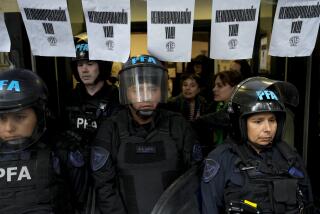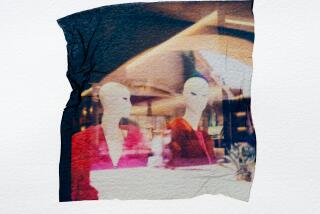In Buenos Aires, bargain hunters say hello to good buys
- Share via
Buenos Aires — First we looked at the bill. Then my wife and I looked at each other in disbelief. This was, after all, Cabana las Lilas, one of the trendiest parrillas in Puerto Madero, Buenos Aires’ trendiest neighborhood. Dinner in the parrilla, or grilled meat house, was our first in the capital, and Stacie and I had just splurged for two gaucho-sized T-bone steaks and a bottle of Mendoza Malbec, a spunky red from Argentina’s premier wine-growing area. The bill barely crept over $30.
In Argentina, sticker shock is a recurring pleasure for foreign visitors. So pleased were we that right after the meal we bought four bottles of 1993 Saint Felicien, a Cabernet Sauvignon, at a posh wine boutique in Recoleta, Buenos Aires’ equivalent of New York’s tony Upper East Side. We paid less than $10 a bottle.
Of course, we could have spent a lot more. We could have bought fancy wines from France or California, imports with prices similar to what we would have paid at home -- and would have paid here only a year ago. And therein lies the primary lesson: The brute strength of the dollar here and the resulting bargain bonanza for visitors applies only to Argentine products and services.
We learned these tips and more in August, when I celebrated my birthday by tagging along with Stacie on her business trip. Just about everything -- meals, drinks, leather jackets, purses, crafts -- was as little as one-third of its 2001 price in dollars, whether at the celebrated Feria de San Telmo (San Telmo Flea Market) or Buenos Aires’ downtown Microcentro, where 11 blocks of the pedestrian avenue Florida are filled with street vendors, upscale boutiques and everything in between.
The peso’s woes
How did the Paris of South America become the Costco of the continent? Internal corruption and mismanagement, predatory international lending and just plain bad luck, a friend and former World Bank analyst told me over beer and sandwiches at Cafe Tortoni, a gem along Buenos Aires’ architectural showcase, Avenida de Mayo.
The denouement has been painful: In January the government was forced to abandon its decade-long charade that the Argentine peso is equal to the American dollar. The peso plummeted. By the time the dust had settled, one dollar bought more than three pesos.
Of course, this gain for overseas tourists comes at the expense of portenos, the city’s residents. Unemployment is around 20%. Especially hard hit are those who poured in from the countryside, where the situation is worse.
Though crime has surged, the increase is largely attributed to petty theft, fraud and vandalism. Other than the anti-Yankee graffiti that adorn foreign investment houses and boarded-up bank windows, we noticed few signs of bad times. And despite the earnest solicitations to “be careful out there” from Stacie’s Argentine business colleagues, we felt in no danger during our four days.
Buenos Aires has two distinct personalities: the bustling, get-it-done-now mode of Monday through Saturday, and the let-it-slide attitude of Sunday. We arrived late on a Saturday, so it was our pleasure to see this metropolis’ more relaxed face first.
Our initial stop Sunday was the Feria de San Telmo, Buenos Aires’ traditional smorgasbord of antiques stalls, street performers and sidewalk cafes in the small, tree-shaded Plaza Dorrego.
For more than a century, locals have come here to browse, bargain and buy from 200-plus stalls selling everything from heirloom jewelry to just plain junk. It’s a must-see on tourists’ itineraries, though non-Argentines are not likely to appreciate the historical value of gaucho art, old tango records and other items.
During our two-hour reconnaissance, we saw quite a few things of interest. I was struck by the fact that no dealer responded to my palpably poor Spanish with outrageously inflated first price quotes.
Among the most pored-over merchandise was memorabilia related to Evita Peron and Carlos Gardel, the man largely credited for popularizing tango in the early 1900s. The items ranged from original press clippings to more recent, kitschy collector’s items. I found myself more engaged by rows of brightly colored seltzer bottles (about $3 to $8) and the free tango show put on by professionals.
For those willing to wander farther afield, a larger Sunday market is held in Belgrano, a neighborhood about five miles northwest of the downtown core. More than 500 dealers set up in Plaza Belgrano. Antiques are available, but the emphasis is on handicrafts.
The bustle downtown
Come Monday, Buenos Aires was back to business as usual, which for us meant more shopping. The city’s main retail area down is called Microcentro. The main drag is Florida, a pedestrian thoroughfare that stretches nearly a mile between Avenida de Mayo to the south and Plaza San Martin to the north. Here and on a cross street, Lavalle, you’ll find scruffy street vendors who spread blankets on the sidewalk as well as the designer houses of Galerias Pacifico, Buenos Aires’ swankiest indoor mall.
Goods ranged from cheap cotton socks to sterling silver polo pony bits. The best buys were leather products: jackets, shoes, belts, wallets, purses and a dizzying assortment of other things that you never thought could -- or should -- be made of cowhide (men’s briefs). Prices as low as $35 for a pair of tasseled calfskin loafers and $10 for a well-crafted belt were enough to make shoppers sing Argentina’s praises like a latter-day Evita.
There’s more: Listed prices (no bargaining here) already include the hefty 21% VAT (also called the IVA), the national value-added tax. And if your purchase is more than $70, you can get about three-quarters of that fee refunded at the airport, provided you can present both parts of your receipt, the bill (factura) and the cheque de reintegro certification, at customs before you go through passport control.
Buenos Aires has other popular commercial districts: Palermo Viejo in the posh Palermo neighborhood; Arenales, a street in the middle-class Barrio Norte district; or anywhere along Avenida Corrientes, home to many of the city’s remarkable collection of bookstores.
After a full day on your feet, you’ll be happy to just sit and watch the fancy footwork at one of Buenos Aires’ dinner and tango shows. Most don’t start until around 10 p.m., so they won’t interfere with evening shopping. And since the price has dropped from about $100 per person to about $30, you can splurge for that bottle of Mendoza Malbec.
*
(BEGIN TEXT OF INFOBOX)
Shopping Argentina
GETTING THERE:
From LAX: LanChile offers direct (at least one stop but no change of planes) and connecting (change of planes) service to Buenos Aires; American, Delta, United and VARIG offer connecting service. Restricted round-trip fares begin at $538.
SHOPPING TIPS:
Credit cards: Inquire about policies before buying anything. Because of deteriorating exchange rates and administrative costs imposed by credit card companies, many merchants levy a 5% to 10% surcharge on credit transactions.
Tax reimbursement: On some purchases, foreign shoppers are entitled to a partial reimbursement of the 21% sales tax. Before returning home, allow enough time at the airport to fill out the paperwork, which is done before you enter passport control.
Restaurants: Tip in cash. Otherwise many restaurants and other service establishments will skim a substantial percentage off the top.
Hotels: Try to stay at an Argentine-owned hotel. You’ll find that favorable changes in the value of the peso are more visible at mid-to-upscale domestic properties (averaging about $50 per night) than at international chains (about $150).
TO LEARN MORE:
Consulate General of Argentina, 5055 Wilshire Blvd., Suite 210, Los Angeles, CA 90036; (323) 954-9155, www.consuladoargentino-losangeles.org.
Argentina Government Tourist Information, 12 W. 56th St., New York, NY 10019; (212) 603-0443, www.sectur.gov.ar.
More to Read
Sign up for The Wild
We’ll help you find the best places to hike, bike and run, as well as the perfect silent spots for meditation and yoga.
You may occasionally receive promotional content from the Los Angeles Times.






